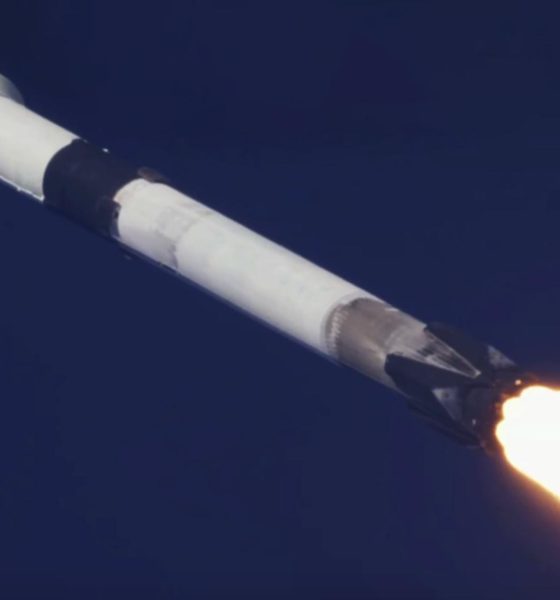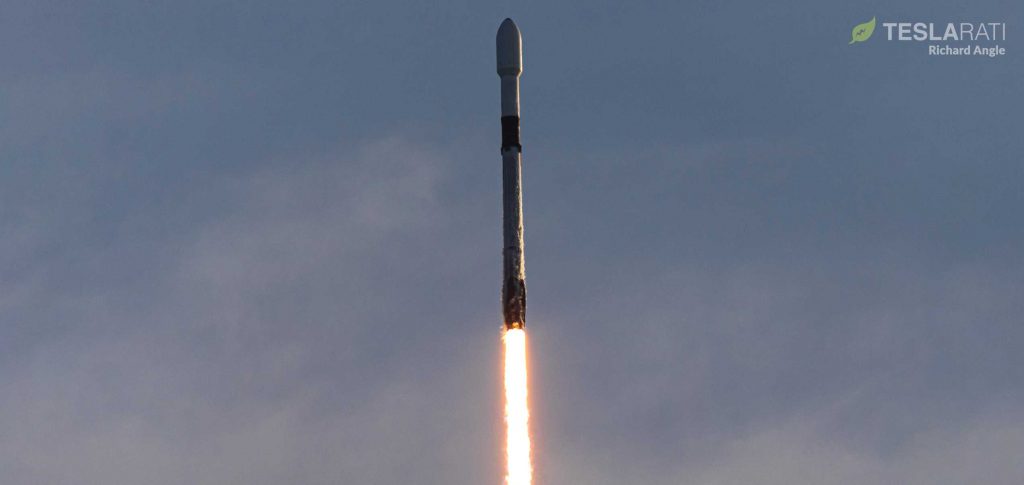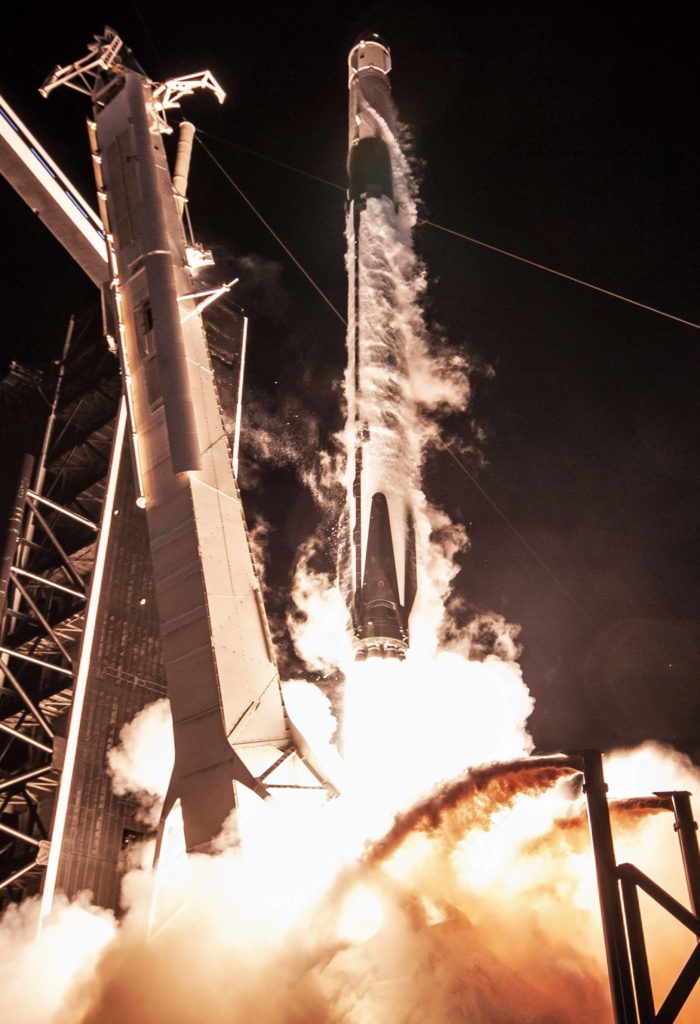

News
SpaceX’s next Starlink launch will have to wait a bit longer
According to NASASpaceflight.com sources, SpaceX’s next Starlink satellite launch will have to wait a bit longer after slipping about a week from its former April 16th target.
Recently discussed on Teslarati, SpaceX has planned what is effectively a “return to flight” launch just weeks after Falcon 9 suffered its first in-flight engine failure in almost eight years. While the rocket was able to adjust on the fly to ensure that the overall Starlink mission was a success, the unprecedentedly reused Falcon 9 booster was lost during its landing attempt. More importantly, the Merlin 1D engine failure immediately raised the concern of NASA and the US military, SpaceX’s most important launch customers.
Expected to launch on thrice-flown Falcon 9 booster B1051, a successful return-to-flight so soon after SpaceX’s Starlink-5 anomaly would strongly imply that the company has already identified and characterized the cause of that March 18th hiccup with a significant degree of confidence. While Starlink-6 (the seventh Starlink launch overall) wont exactly replicate the conditions preceding Starlink-5’s in-flight engine failure, a successful launch would hopefully help alleviate any major concerns from SpaceX’s customers. That mission, however, will now have to wait another week or so to launch.

While not quite as flight-proven as B1048, the Falcon 9 booster that suffered an engine failure and was lost at sea last month, SpaceX (according to Next Spaceflight) has assigned Falcon 9 booster B1051 to its seventh Starlink launch. Since its first flight in March 2019, supporting Crew Dragon’s historic orbital launch debut, B1051 has completed two additional orbital-class launches and landings, lofting Canada’s three-satellite Radarsat Constellation Mission (RCM) in June 2019 and SpaceX’s fourth batch of 60 Starlink satellites in January 2020.



The Starlink-6 (Flight 7) mission will be B1051’s fourth, making it the sixth SpaceX Falcon 9 booster to launch four times since booster B1048 pushed the envelope in November 2019 – just five months ago. Aside from Falcon 9 B1048’s Starlink-5 engine failure and subsequently unsuccessful landing attempt, SpaceX also lost booster B1056 after its fourth flight in February 2020. Excluding two or three new Falcon 9 boosters assigned to critical missions for NASA and the US military, those two booster losses shrunk SpaceX’s rocket fleet by 30-40%, leaving just three flight-proven Falcon 9 boosters for other Starlink or customer missions.
SpaceX does have two twice-flown Falcon Heavy side boosters, said by CEO Elon Musk to be relatively easy to convert into Falcon 9 boosters, but their status is currently unknown, leaving them as the wildcards of SpaceX’s rocket fleet.

For SpaceX to be able to continue an ambitious Starlink launch cadence throughout the rest of 2020, the successful recovery of flight-proven boosters like B1051, B1049, and B1059 will likely be uniquely paramount over the next few months. Assuming SpaceX is able to successfully launch its first astronauts on Crew Dragon (NET late May) and complete a second US military GPS satellite launch (NET June 30th), two once-flown boosters will thankfully enter the company’s fleet, raising it to five (or seven) strong in by July or August.
SpaceX’s next Starlink launch is now scheduled for no earlier than (NET) April 22nd, give or take a day or two.

Elon Musk
Elon Musk’s X will start using a Tesla-like software update strategy
The initiative seems designed to accelerate updates to the social media platform, while maintaining maximum transparency.

Elon Musk’s social media platform X will adopt a Tesla-esque approach to software updates for its algorithm.
The initiative seems designed to accelerate updates to the social media platform, while maintaining maximum transparency.
X’s updates to its updates
As per Musk in a post on X, the social media company will be making a new algorithm to determine what organic and advertising posts are recommended to users. These updates would then be repeated every four weeks.
“We will make the new 𝕏 algorithm, including all code used to determine what organic and advertising posts are recommended to users, open source in 7 days. This will be repeated every 4 weeks, with comprehensive developer notes, to help you understand what changed,” Musk wrote in his post.
The initiative somewhat mirrors Tesla’s over-the-air update model, where vehicle software is regularly refined and pushed to users with detailed release notes. This should allow users to better understand the details of X’s every update and foster a healthy feedback loop for the social media platform.
xAI and X
X, formerly Twitter, has been acquired by Elon Musk’s artificial intelligence startup, xAI last year. Since then, xAI has seen a rapid rise in valuation. Following the company’s the company’s upsized $20 billion Series E funding round, estimates now suggest that xAI is worth tens about $230 to $235 billion. That’s several times larger than Tesla when Elon Musk received his controversial 2018 CEO Performance Award.
As per xAI, the Series E funding round attracted a diverse group of investors, including Valor Equity Partners, Stepstone Group, Fidelity Management & Research Company, Qatar Investment Authority, MGX, and Baron Capital Group, among others. Strategic partners NVIDIA and Cisco Investments also continued support for building the world’s largest GPU clusters.
News
Tesla FSD Supervised wins MotorTrend’s Best Driver Assistance Award
The decision marks a notable reversal for the publication from prior years, with judges citing major real-world improvements that pushed Tesla’s latest FSD software ahead of every competing ADAS system.

Tesla’s Full Self-Driving (Supervised) system has been named the best driver-assistance technology on the market, earning top honors at the 2026 MotorTrend Best Tech Awards.
The decision marks a notable reversal for the publication from prior years, with judges citing major real-world improvements that pushed Tesla’s latest FSD software ahead of every competing ADAS system. And it wasn’t even close.
MotorTrend reverses course
MotorTrend awarded Tesla FSD (Supervised) its 2026 Best Tech Driver Assistance title after extensive testing of the latest v14 software. The publication acknowledged that it had previously criticized earlier versions of FSD for erratic behavior and near-miss incidents, ultimately favoring rivals such as GM’s Super Cruise in earlier evaluations.
According to MotorTrend, the newest iteration of FSD resolved many of those shortcomings. Testers said v14 showed far smoother behavior in complex urban scenarios, including unprotected left turns, traffic circles, emergency vehicles, and dense city streets. While the system still requires constant driver supervision, judges concluded that no other advanced driver-assistance system currently matches its breadth of capability.
Unlike rival systems that rely on combinations of cameras, radar, lidar, and mapped highways, Tesla’s FSD operates using a camera-only approach and is capable of driving on city streets, rural roads, and freeways. MotorTrend stated that pure utility, the ability to handle nearly all road types, ultimately separated FSD from competitors like Ford BlueCruise, GM Super Cruise, and BMW’s Highway Assistant.
High cost and high capability
MotorTrend also addressed FSD’s pricing, which remains significantly higher than rival systems. Tesla currently charges $8,000 for a one-time purchase or $99 per month for a subscription, compared with far lower upfront and subscription costs from other automakers. The publication noted that the premium is justified given FSD’s unmatched scope and continuous software evolution.
Safety remained a central focus of the evaluation. While testers reported collision-free operation over thousands of miles, they noted ongoing concerns around FSD’s configurable driving modes, including options that allow aggressive driving and speeds beyond posted limits. MotorTrend emphasized that, like all Level 2 systems, FSD still depends on a fully attentive human driver at all times.
Despite those caveats, the publication concluded that Tesla’s rapid software progress fundamentally reshaped the competitive landscape. For drivers seeking the most capable hands-on driver-assistance system available today, MotorTrend concluded Tesla FSD (Supervised) now stands alone at the top.
News
Elon Musk’s Grokipedia surges to 5.6M articles, almost 79% of English Wikipedia
The explosive growth marks a major milestone for the AI-powered online encyclopedia, which was launched by Elon Musk’s xAI just months ago.

Elon Musk’s Grokipedia has grown to an impressive 5,615,201 articles as of today, closing in on 79% of the English Wikipedia’s current total of 7,119,376 articles.
The explosive growth marks a major milestone for the AI-powered online encyclopedia, which was launched by Elon Musk’s xAI just months ago. Needless to say, it would only be a matter of time before Grokipedia exceeds English Wikipedia in sheer volume.
Grokipedia’s rapid growth
xAI’s vision for Grokipedia emphasizes neutrality, while Grok’s reasoning capabilities allow for fast drafting and fact-checking. When Elon Musk announced the initiative in late September 2025, he noted that Grokipedia would be an improvement to Wikipedia because it would be designed to avoid bias.
At the time, Musk noted that Grokipedia “is a necessary step towards the xAI goal of understanding the Universe.”
Grokipedia was launched in late October, and while xAI was careful to list it only as Version 0.1 at the time, the online encyclopedia immediately earned praise. Wikipedia co-founder Larry Sanger highlighted the project’s innovative approach, noting how it leverages AI to fill knowledge gaps and enable rapid updates. Netizens also observed how Grokipedia tends to present articles in a more objective manner compared to Wikipedia, which is edited by humans.
Elon Musk’s ambitious plans
With 5,615,201 total articles, Grokipedia has now grown to almost 79% of English Wikipedia’s article base. This is incredibly quick, though Grokipedia remains text-only for now. xAI, for its part, has now updated the online encyclopedia’s iteration to v0.2.
Elon Musk has shared bold ideas for Grokipedia, including sending a record of the entire knowledge base to space as part of xAI’s mission to preserve and expand human understanding. At some point, Musk stated that Grokipedia will be renamed to Encyclopedia Galactica, and it will be sent to the cosmos.
“When Grokipedia is good enough (long way to go), we will change the name to Encyclopedia Galactica. It will be an open source distillation of all knowledge, including audio, images and video. Join xAI to help build the sci-fi version of the Library of Alexandria!” Musk wrote, adding in a later post that “Copies will be etched in stone and sent to the Moon, Mars and beyond. This time, it will not be lost.”








